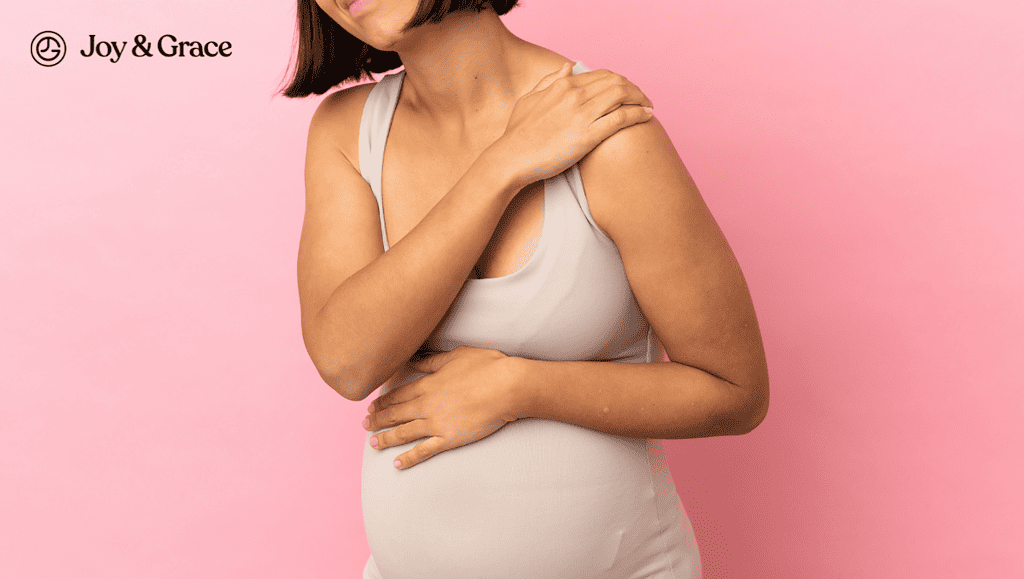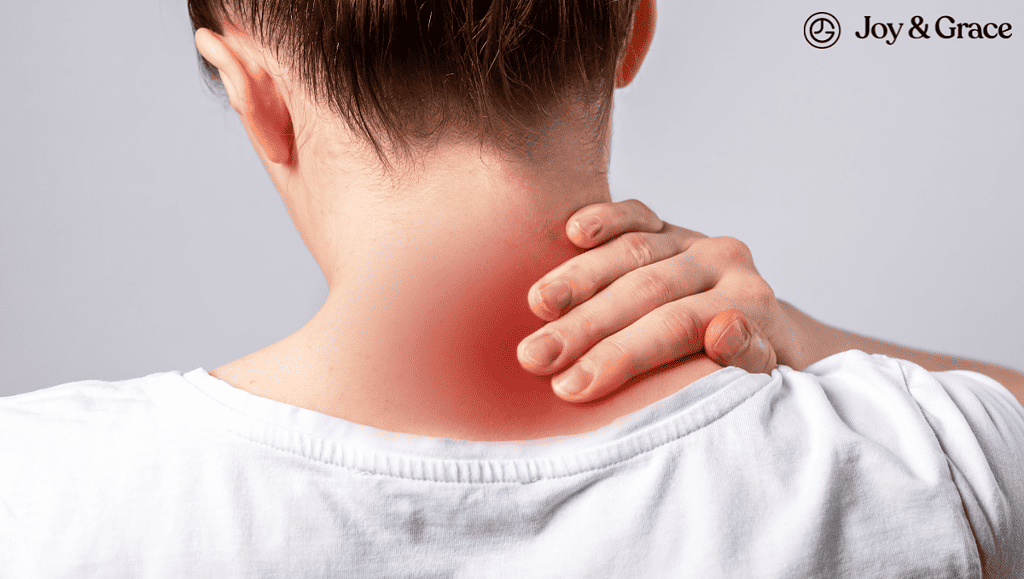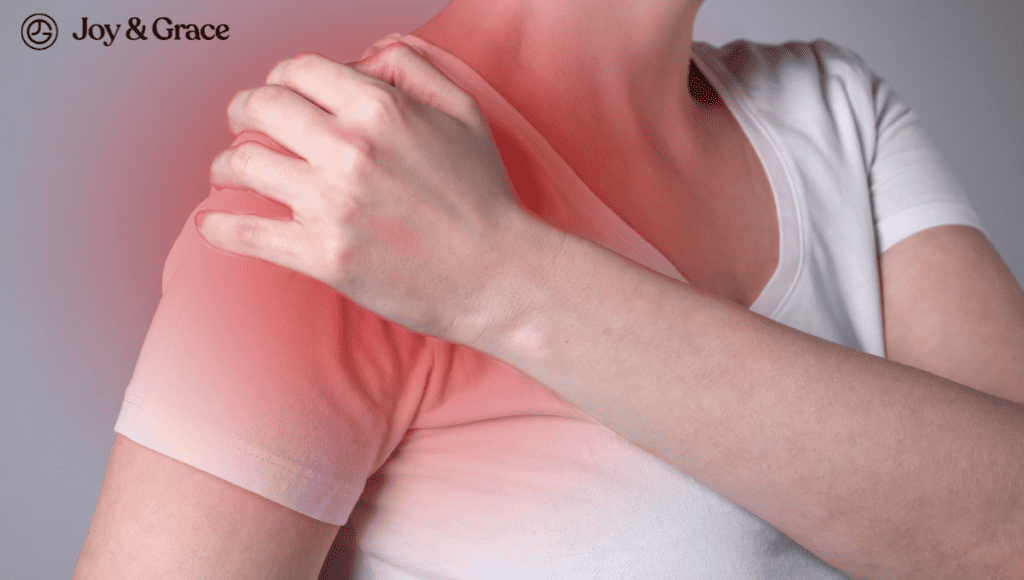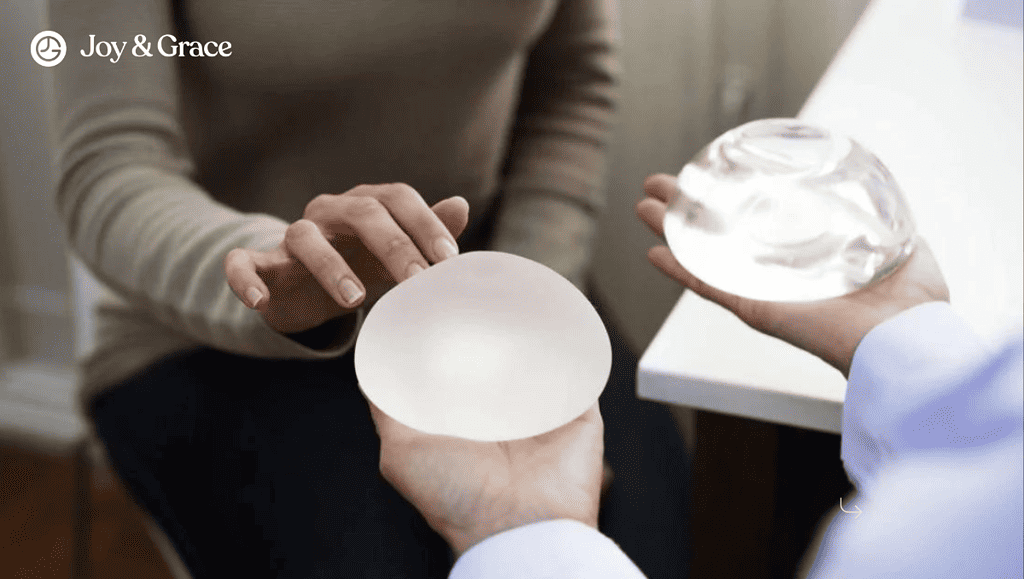Conditions that present with a rash and joint pain (shoulder included) vary considerably.
In some cases, the shoulder pain and rash are not linked at all. In other cases, the rash and shoulder pain could indeed be linked. Unfortunately, the link could be due to potentially severe disease as well.
Rashes are visible. And they might itch, burn, or hurt. Many people might get anxious when they see a rash. And we understand that.
Still, we wouldn’t recommend you try and diagnose your rash and joint/shoulder pain with this article (or any other website). Not because this article is not factual, but because there are just too many factors to diagnosing rashes and joint pain.
You could stress yourself too much if you try to confirm a diagnosis online. This, in turn, could make everything worse.
So, please treat this article as a brief guide. Everything you read here is factual, but a visit to the doctor is still our ultimate recommendation.
Also, although some conditions can cause both a rash and only shoulder pain, most of them hurt many joints simultaneously, including the shoulder.
To highlight that, we will sometimes use the term joint/shoulder pain throughout the article.
With that said, let's hop on into an overview of conditions that can cause a rash and joint/shoulder pain.
What Appears As A Rash With Shoulder Joint Pain?
Sometimes what appears as a rash with shoulder pain is not because of any disease.
It could simply be a coincidence of two (non-serious) unrelated things that are nothing to worry about.
Training your shoulders too hard in the gym and vigorously scratching off a mosquito bite could cause a perfect combination of shoulder pain and a lesion that looks like a rash.
In other cases, the rash might be genuine but not linked to your shoulder pain (pre-existing shoulder pain, for example). A guide solely for rashes would make this article very long (and boring.)
However, in a small number of cases, there may indeed be some kind of common condition behind everything. And there’s usually something “systemic” (affecting the whole body) that’s the culprit.
Now, to sum them up, some of the conditions that cause both a rash and joint (shoulder) pain are the following:
- Viral infections
- Different kinds of arthritis
- Lupus, and
- Dermatomyositis.
Let’s start discussing these conditions in more detail.
1. Viral Infections
Joint pain/inflammation is a well-recognized and relatively common occurrence with viral infections.
Most viruses cause “arthralgias” (joint pain that usually passes). However, some could also cause true arthritis (long-term joint pain caused by inflammation of the joints).
Here are some of the most common viral infections that can cause a rash and joint/shoulder pain:
- Shingles (Herpes Zoster)
Shingles are caused by the same virus as chickenpox, called varicella-zoster virus (VZV).
When a person gets over chickenpox, the virus stays dormant in their body. This virus can come back and cause shingles years later. According to the CDC, about 1 in every 3 people in the United States develops shingles during their lifetime.
Shingles is a painful rash that only appears on one side of the face or body. The rash is made up of blisters that usually crust over in 7–10 days and go away completely in 2–4 weeks. One of the places it may appear is also the shoulder.
Because it is a painful rash, if it appears in the shoulder, it causes, you guessed it, a rash and pain in the shoulder.
People often feel pain, itching, or tingling in the area where the rash will show up before it does. This could happen a few days before the rash shows up.
Most of the time, the rash shows up as a single stripe on the left or right side of the body. The rash can appear on the face as well.
Shingles on the face can make the eye hurt and even make it hard to see.
In rare cases (usually in people whose immune systems aren't as strong), the rash can be more widespread and look like chickenpox.
Shingles can also cause other problems, such as:
- Fever,
- Headaches,
- Chills, and
- Stomachaches.
- Hepatitis A virus
Hepatitis A virus infection causes shoulder/joint pain and a rash in 10% to 15% of people.
Hepatitis A is caused by the hepatitis A virus (HAV) and is found worldwide.
Unfortunately, the number of new cases of hepatitis A infection is continuously on the rise in the US:
- 3,366 cases in 2017,
- 12,474 cases in 2018,
- 18,846 cases in 2019.
According to the CDC, this raise is mainly because of:
- An increase in the number of drug users and homeless people, and
- An increase in the number of hepatitis A outbreaks among men having sex with other men.
HAV is usually spread by what’s called the “fecal-oral” route (either via person-to-person contact or consumption of contaminated food or water).
Risk factors for HAV transmission include:
- Living in or traveling to areas with poor sanitation,
- Living with or having sexual contact with someone who has hepatitis A,
- Being exposed to daycare centers,
- Being exposed to residential institutions, and
- Using intravenous drugs.
Most adults with HAV infection get sick quickly with symptoms like nausea, loss of appetite, fever, unwellness, and stomach pain.
If you’re infected, within a few days to a week, there may be dark urine and stools that smell like alcohol.
Then, you'll have jaundice and itchy skin. When jaundice shows up, the early symptoms usually go away, and jaundice usually reaches its worst within two weeks.
Luckily, hepatitis A is usually a short-term disease that goes away on its own.
- Hepatitis B virus
Hepatitis B is another infection of the liver. It can be passed on through blood, semen, and fluids from the genital area.
According to the U.S. Department of Health & Human Services, 850,000 people in the U.S. are estimated to be living with hepatitis B.
Furthermore, the department claims that the actual number might actually be as high as 2.2 million. In addition, 67% of people with hepatitis B infection might not even know they have the virus.
To return to our primary talking point, it is estimated that the Hepatitis B virus causes a rash in 14.5% of all cases.
Joint (shoulder) pain is another common symptom during the acute phase.
Other symptoms include:
- Fever,
- Feeling very tired,
- Pain in your upper tummy,
- Having a sickening feeling,
- Yellowing of the skin and whites of the eyes (jaundice).
The infection usually lasts 1 to 3 months, and most people either have no or mild symptoms.
Most of the time, hepatitis B goes away without treatment. You might be given painkillers or medicines to stop you from feeling sick to help with the symptoms.
Your doctor will send you to a liver specialist to check your liver's health.
Hepatitis B that lasts for more than 6 months is considered long-term or chronic.
Chronic hepatitis B is often treated with antivirals and medicines that help with symptoms like itching, pain, and feeling sick. You will also need regular checkups with a liver specialist if you have chronic hepatitis B.
But, most people who get hepatitis B don't have any long-term problems because of it.
If you don't get treatment for chronic hepatitis B, however, it can damage your liver and make you more likely to get liver cancer.
To ensure your liver is working well, you should take any medicine you've been given and get regular checkups.
- Enteroviruses
Joint (shoulder), muscle pain, and a rash are sometimes symptoms of enterovirus infection.
Enterovirus is a respiratory type of infection that is widespread. Enteroviruses are found everywhere on Earth.
In the United States alone, it is estimated that 10 to 15 million new cases of enterovirus infection are registered every year. Most new cases are usually reported in the fall and summer.
Most enteroviruses are spread through the fecal-oral route. But there are some exceptions. Some types, for example, are spread by secretions from the nose and throat.
Infants, children, and teenagers are at higher risk than adults of having symptoms. Still, people of any age can get infected and develop symptoms.
The viral infection has a short incubation period of three to five days. After that, fever, headache, and other body symptoms appear.
As we said earlier, a rash, joint (shoulder), and muscle pain are also sometimes present in some people.
In addition, patients also have nausea, vomiting, diarrhea, and abdominal pain.
Symptoms usually last only two to four days.
- Parvovirus B-19
This virus is known for causing "fifth disease," or “erythema infectiosum,” which is more common in children. However, it can still affect people of any age.
This is another viral infection that can cause a rash and joint (shoulder) pain. However, the appearance of a rash is less common in adults. Joint pain/inflammation can happen along with or after the skin rash. Up to 60% of infected adults show signs in their joints.
When a person with Parvovirus B19 coughs or sneezes, the virus spreads through their saliva, sputum, or nasal mucus. Parvovirus B19 can also be spread by blood or by-products made from blood.
If a pregnant woman has parvovirus B19, she can pass it on to her baby.
You should talk to your obstetrician if you’re pregnant and think you’ve been exposed to the parvovirus.
People in the U.S. are more likely to get sick with parvovirus B19 in late winter, spring, and early summer. Parvovirus B19 infection causes small outbreaks about every 3 to 4 years.
Since parvovirus B19 only affects people, a dog or cat can't give a person the virus. Also, a sick person can't give parvovirus B19 to a dog or cat.
2. Different Kinds Of Arthritis
"Arthritis" literally means joint inflammation. Most types of arthritis (such as rheumatoid arthritis) are thought to be “autoimmune,” which means they’re caused by a problem with the immune system that makes the body attack its own tissues- in this case, in the joints. By doing so, additional signs, such as rashes, could also appear.
Another highlight of autoimmune diseases is that they’re much more common in women than in men. It is estimated that 80% of all people affected by autoimmune diseases are women. This is thought to be caused by variations in the sex chromosomes and hormonal changes.
The types of arthritis that present as a rash with joint (shoulder) pain include the following:
Psoriatic Arthritis
The word "psoriasis" is from Greek, meaning "itching condition" or "being itchy."
It is estimated that more than 500,000 people in the US have psoriatic arthritis. The average age of disease onset is between 30 and 50.
Psoriatic arthritis is a long-term disease that causes thick, red skin patches often covered with silvery scales.
In addition, because it is a form of arthritis, it also causes joint pain, swelling, and stiffness. The shoulder joint can also be affected.
In one particular study, among 87 patients with psoriatic arthritis, 38 had shoulder joint involvement.
Both men and women can get psoriatic arthritis. Most people with psoriatic arthritis first develop signs of psoriasis on their skin, then signs of arthritis.
However, in about 15% of cases, arthritis symptoms appear before the psoriasis.
In another 15%, psoriasis, and arthritis are found both at the same time.
Regarding the cause, no one really knows what causes psoriatic arthritis.
Researchers think it may happen due to hereditary and environmental factors. They also believe that problems with the immune system, infections, or being overweight could affect who gets the disease.
Adult-Onset Still’s Disease
Adult Still's disease is a rare type of arthritis. It is estimated that it affects less than 1 person in 100.000 people.
Still's disease in adults doesn't have a clear cause. Some researchers think it might come after a bacterial or viral infection.
This disease causes fevers, rashes, and joint pain. Some adults with Still's disease only have one episode. In other people, the problem stays or comes back.
This inflammation can damage the joints it affects, especially the wrists. Medicines like prednisone that help control inflammation are used to treat the condition.
What Does An Arthritis Rash Look Like?
Before we start discussing rashes, we need a quick guide to the terms “macules” and papules” used when describing skin rashes.
“Macules” are flat skin spots with a diameter of less than 1 cm. When a “macula” is bigger than 1 cm, it is called a patch.
“Papules” are raised, round skin spots less than 1 cm in diameter. When papules are bigger than 1 cm, they are called plaques.
"Maculopapular rash" means an outbreak of both flat and raised bumps on the skin.
Rashes In Psoriatic Arthritis
Different types of rashes can appear in psoriatic arthritis.
Here, we'll talk about the five most common types, from most common to least common. Remember that people can have more than one kind of psoriasis simultaneously.
1. Plaque psoriasis
Plaque psoriasis can happen anywhere, but it most often appears on the elbows, knees, and scalp.
It forms pink, red, or violet bumps on the raised skin. The spots may also have a thick white or silver scale on them.
Spot size can vary a lot. Sometimes, they may be as small as a dime. In other cases, they might be as big as a football (bigger than the size of your hand).
2. Inverse psoriasis
Inverse psoriasis affects skin folds, like your armpits and groin, between your buttocks, and under your breasts. It forms wet, red skin patches that may not have a lot of scales.
This type of psoriasis can be mistaken for a skin infection, which can also cause red patches of skin.
One difference between skin infections and inverse psoriasis is that skin infections can have more scales or yellow crust. You may need to visit a dermatologist (skin doctor) to know which one you have.
This type usually appears in people under 30 and develops a rash on their chest, arms, and legs. It makes small pink or red spots about the size of a coin. On top of the spots, there may be tiny white scales. This kind of psoriasis can occur after some infections, like strep throat.
In this type of psoriasis, pus-filled bumps about the size of a pencil eraser show up. Most bumps are surrounded by red skin that can be very painful. Different parts of your body can be affected by this type, including your palms and soles.
This kind of psoriasis is rare and life-threatening. It makes the skin very red and flaky. It can affect large portions of the skin at once. People with this kind of psoriasis may also have fever and chills. This kind of rash can be a medical emergency, so you must call your healthcare provider or 911 if you notice these signs.
Rashes In Adult Onset Still’s Disease
Still’s disease presents various rashes, usually appearing when the fever increases. In most cases, the rash appears on the extremities (like the lower legs) and the trunk.
The rash is most commonly formed by “macular” or “maculopapular” lesions that are salmon pink.
In other cases, the wounds comprise “papules” and red plaques with scales or crusts, most often on the trunk (chest, back, and arms) and the limbs.
In other parts of people, rashes appear as “urticaria.” “Hives” is another common term for urticarias.
3. Lupus
The long name for lupus is “systemic lupus erythematosus,” or SLE.
On average, 73 out of 100,000 people in the U.S. have lupus, another autoimmune disease.
Although lupus affects people of all ages, it's most often diagnosed in those between the ages of 15 and 45.
Lupus is well known to cause joint pain and a rash.
Up to 95% of patients with lupus report joint pain. However, the shoulder joint is significantly less affected.
A rash is also very prevalent among lupus patients. Many rash forms may appear, but the “malar rash” is the most widely known.
The malar rash is characterized by a red rash on the cheeks and bridge of the nose. It usually doesn't hurt or itch but often shows up or worsens when exposed to sunlight.
About 70 to 80% of people develop some kind of rash during the course of the disease.
It is not clear what causes lupus.
What Are The Early Signs Of Lupus In Females?
The early signs of lupus are sometimes vague. They usually include things like:
- Extreme fatigue,
- A rash and other skin lesions (first sign in 20% of all cases)
- A vague feeling of discomfort or illness (malaise),
- Fever,
- Loss of appetite,
- Weight loss, and
- Joint pain.
After that, more specific signs start to appear.
About one-third of SLE patients get kidney disease (nephritis).
Heart problems can also happen with SLE. People with SLE are even more likely to have atherosclerosis. This heart disease occurs when fat builds up in the blood vessels.
The inflammation that is a part of SLE can also hurt the nervous system. This can cause strange feelings and weakness in the limbs (peripheral neuropathy), seizures, strokes, and trouble processing, learning, and remembering information (cognitive impairment). A lot of people with SLE also have anxiety and depression.
People with SLE have times when their illness gets worse (called "exacerbations") and times when it gets better (remissions).
In most cases, SLE tends to worsen over time. Unfortunately, damage to the body's major organs can sometimes be so bad that it can be fatal.
4. Dermatomyositis
Myositis is a group of rare conditions that affect the muscles. Myositis occurs in about one person per 100,000 people. In most types of myositis, the disease's prevalence is two times higher in women than in men.
Out of all kinds of myositis, the type called dermatomyositis is the one that presents most commonly with joint (shoulder) pain and a rash. Polymyositis is another type of myositis, but it usually doesn’t involve the skin.
Most adults get dermatomyositis between the ages of 40 and 60.
Dermatomyositis forms many kinds of rashes.
The most common areas where a rash appears are the face and eyelids, as well as your knuckles, elbows, knees, chest, and back. The rash can also be itchy and painful.
Then, after the rash appears, muscle symptoms also start to develop.
What Are The First Signs Of Myositis?
The first main signs of dermatomyositis are muscle weakness and skin changes. The disease can come on slowly or quickly.
Other symptoms of dermatomyositis include:
- A painful or itchy red or purple rash on sun-exposed areas.
- Upper eyelids that are red or purple and swollen (heliotrope).
- “Gottron's papules,” which are red or purple spots on the knuckles, elbows, knees, and toes.
- “Raynaud's phenomenon” - Joints that turn very pale and feel stiff in cold weather. When warmed up, the color comes back to normal.
- Scaly, rough, and dry skin (this can cause hair loss).
- Red, swollen spots near the fingernails.
- Calcium deposits which form hard lumps under the skin (calcinosis).
- Neck, hip, back, and shoulder muscle weakness.
- Trouble with swallowing and a change in voice.
- Tiredness, a fever, and losing weight.
- Muscle aches.
- Muscle weakness makes it hard to get out of a chair or bed.
Muscle weakness can sometimes spread to the heart, intestines, and lungs. This can make it hard to breathe and make you cough.
Takeaway
- Your shoulder pain and rash could sometimes be just a coincidence of two completely unserious things that are nothing to worry about.
- If there’s true disease present, most of the medical conditions that cause a rash and shoulder pain also affect other joints. Isolated cases of pure shoulder pain and a rash are very rare.
- For viral infections, you need to be aware of things that put you at risk. Not having good hygiene or having sexual contact with someone infected are some risk factors.
- If the rash and shoulder pain is caused by some kind of arthritis, early diagnosis is key. Because it’s usually a chronic disease, you must properly manage its symptoms from the beginning.
- The same goes if the rash is caused by more severe conditions like lupus or dermatomyositis. Avoiding sun exposure is another preventive measure in conditions like this.
All in all, only a visit to a doctor gives you a proper diagnosis and peace of mind.
As we’ve said, it could turn out to be something nothing to worry about at all.
We appreciate you taking the time to read this article and hope it helped you somehow. Take care, and see you in the next article!















